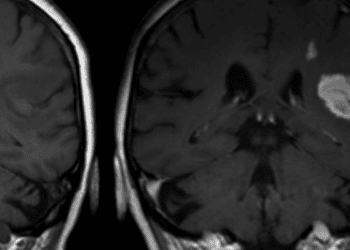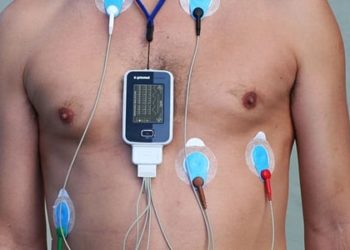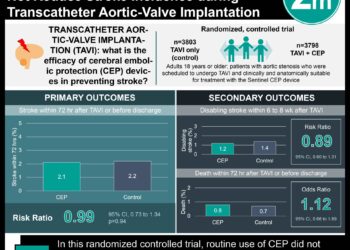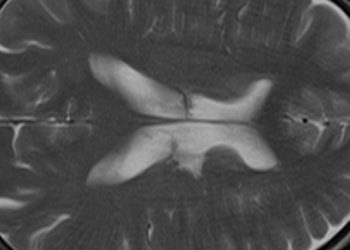Contact aspiration with stent retrieval no more effective than stent retrieval alone for thrombectomy revascularization in stroke patients
1. The rate of near/total revascularization was not significantly different following stent retrieval and contact aspiration versus stent retrieval alone amongst a sample of 405 patients with acute ischemic stroke and large vessel occlusion.
2. The stent retrieval and contact aspiration group trended towards a higher rate of revascularization; it is possible that this trial was underpowered to detect small differences between groups.
Evidence Rating Level: 1 (Excellent)
Study Rundown: Mechanical thrombectomy is the well-established gold standard in the treatment of acute ischemic stroke with large vessel occlusion. Thrombectomy frequently achieves reperfusion of damaged tissue in a timely manner which is highly predictive of a good clinical outcome. Early studies have demonstrated that adding contact aspiration to stent retrieval may have even greater efficacy at achieving reperfusion compared to traditional thrombectomy. The present randomized controlled trial sought to compare contact aspiration and stent retrieval in combination (CA/SR) versus stent retrieval (SR) alone in the management of stroke patients. This was a multicentre trial which included data from 405 adult patients in total. Secondary outcomes included neurological and functional status, as well as structural changes to the cerebrum (i.e., hemorrhagic transformation) assessed by CT 24 hours after treatment. The percent of patients who achieved near-total or total reperfusion following treatment was not significantly different between the groups; 64.5% in the CA/SR group and 57.9% in the SR group achieved the primary outcome. Of the secondary outcomes assessed, most (12/14) goals of recovery were no different between the two groups, although there was a trend towards improved outcomes in the CA/SR group. This trial contributes to our understanding of optimal stroke management, despite its negative results. It shows that although largely no differences were detected so far, data demonstrated some promise for the addition of CA to SR in the mechanical treatment of ischemic stroke. The study included a broad population from several centres across France and in this sense has high external validity. Some drawbacks to this study include its relatively low sample size which might have caused it to be underpowered to detect differences compared to the projected sample size. Additionally, the eligibility criteria contained vague descriptions of medical comorbidities and patient features which may have excluded patients from participating in the trial if they were unlikely to benefit from the procedure. Although this may have been prudent clinical decision making, it may also introduce some selection bias. Otherwise, this is a large, blinded, randomized clinical trial with strong methodology which assesses a range of clinical outcomes and provides important information about stroke treatment.
Click to read the study in JAMA
Relevant Reading: Acute ischaemic stroke interventions: large vessel occlusion and beyond
In-Depth [randomized controlled trial]: Patients were enrolled between October 2017 and June 2018, and were followed for three months. Individuals who had suffered an acute ischemic stroke with occlusion of a large vessel in the anterior circulation within 8 hours of presentation to the hospital were eligible for inclusion. Patients were recruited from 11 different high-volume stroke centres in France, and randomized in a 1:1 ratio to CA/SR or SR groups. High-volume designation implied that the centre performs at least 100 thrombectomies annually, and each treating physician performed at least thrombectomies 10 each. The Expanded Thrombolysis in Cerebral Infarction scale (eTICI) was used to assess degree of vessel occlusion at baseline and after treatment. Randomization was performed using a dynamic method described in the literature which balanced participant groups by age (above/below 70 years), prior use of thrombolysis and thrombus location. The eTICI score was calculated using baseline angiography and imaging; the primary outcome was eTICI scores of 2c or 3, representing near-total and total revascularization, respectively. Neurological and functional status were scored using the National Institutes of Health Stroke Scale (NIHSS). Quality of life was also assessed 12 months after treatment. Researchers were blinded to patient allocation. Initially, 408 patients were recruited and 405 were randomized; of this group, 23 patients did not undergo their assigned treatment most often due to spontaneous clot resolution or another changing factor which would impact their clinical care. The primary outcome was achieved in 64.5% of the CA/SR group versus 57.9% in the SR group; the adjusted risk difference between groups was 6.6% (95% confidence interval [95CI] -3.0% to 16.2%) and the adjusted odds ratio was 1.33 (95CI 0.88 to 1.99), indicating nonsignificance. Amongst the secondary outcomes, the CA/SR group had a significantly higher rate of reperfusion (including eTICI 2b50) after the first-allocated intervention (adjusted odds ratio 2.54, 95CI 1.51-4.28). The median time to reperfusion was not significantly different between groups: 42 minutes in the CA/SR group and 44 minutes in the SR group. A sensitivity analysis by study site found similar results with 62.6% of patients in the CA/SR group and 57.9% of the patients in the SR group achieving reperfusion. There were no differences in mean scores for neurologic, functional and quality of life outcomes assessed up to 12 months after treatment.
Image: PD
©2021 2 Minute Medicine, Inc. All rights reserved. No works may be reproduced without expressed written consent from 2 Minute Medicine, Inc. Inquire about licensing here. No article should be construed as medical advice and is not intended as such by the authors or by 2 Minute Medicine, Inc.







